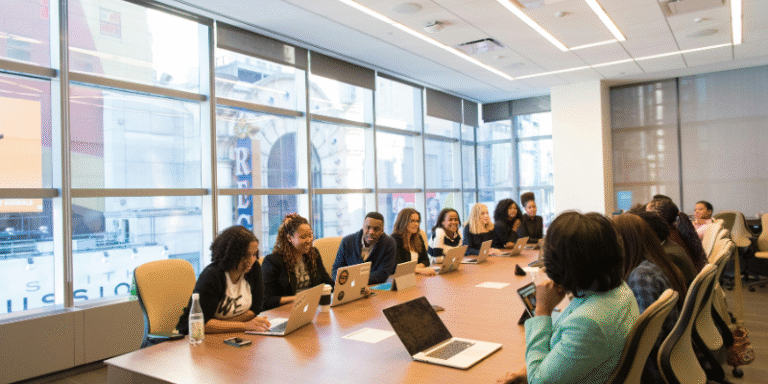In today’s fast-paced professional environment, meetings are essential for coordination, decision-making, and collaboration. Yet, staying present and engaged during them can be challenging. Disengagement—caused by distractions, unclear objectives, or fatigue—reduces productivity and morale. Research consistently shows that poor engagement in meetings leads to inefficiency and diminished employee well-being (Lehmann-Willenbrock, Allen & Belyeu, 2017). Therefore, maintaining attention requires a blend of psychological awareness, behavioural discipline, environmental management, and effective meeting design.
1.0 The Importance of Engagement in Meetings
Engagement goes beyond physical presence; it involves mental focus, emotional investment, and active participation. Kahn (1990) defines personal engagement as a state in which individuals express themselves physically, cognitively, and emotionally during role performance. When employees find meetings meaningful, feel psychologically safe, and perceive that their input matters, engagement naturally increases. Conversely, when meetings lack structure or purpose, disengagement and frustration occur.
Lehmann-Willenbrock et al. (2017) argue that engaged participants contribute to collaboration, creativity, and shared problem-solving, all of which strengthen organisational culture. For example, Google’s re:Work project highlights that teams with high psychological safety and open communication outperform those with less inclusive dynamics. Engagement is thus both a personal responsibility and an organisational necessity.
2.0 Cognitive and Psychological Strategies
2.1 Mindfulness
Mindfulness, the practice of focusing attention on the present moment, enhances awareness and reduces stress. Brown and Ryan (2003) found that mindfulness improves emotional regulation and concentration—key qualities for staying engaged. Practising brief mindfulness exercises before meetings, such as deep breathing or guided meditation, helps individuals centre themselves.
Hülsheger et al. (2013) observed that employees who regularly engage in mindfulness activities report less emotional exhaustion and better focus during collaborative tasks. For instance, some organisations now begin virtual meetings with a short “minute of silence” to promote mental readiness—a small yet powerful technique for boosting engagement.
2.2 Goal-Setting and Preparation
Preparation sets the stage for attentiveness. Locke and Latham’s (2002) Goal Setting Theory suggests that specific, challenging goals enhance motivation and task focus. Reviewing the agenda, identifying one’s role, and listing potential discussion points beforehand promote clarity and confidence. Drucker (2006) also stresses that purpose-driven participation—knowing why one is in the meeting—transforms attendees from passive listeners into active contributors.
For example, sales managers who review client data before team discussions are better equipped to share insights, ask informed questions, and stay alert throughout the session.
3.0 Behavioural Techniques
3.1 Active Listening
Active listening is one of the most effective ways to remain present. It involves paying full attention, providing nonverbal feedback, and responding appropriately (Rogers & Farson, 1957). Maintaining eye contact, nodding, and paraphrasing key points demonstrate attentiveness.
Kluger and DeNisi (1996) found that effective feedback exchanges enhance performance and interpersonal connection, both of which are vital in meetings. For instance, rephrasing a colleague’s idea (“So, you’re suggesting that we…”) confirms understanding and keeps participants cognitively engaged.
3.2 Asking Questions and Participating
Actively contributing—by asking questions or sharing opinions—stimulates mental engagement and accountability. Edmondson (1999) introduced the concept of psychological safety, where individuals feel safe to express themselves without fear of ridicule. In such environments, even introverted team members are more willing to participate.
Frazier et al. (2017) reinforce that psychological safety enhances engagement and collaboration. Team leaders can encourage inclusivity by prompting quieter members to contribute or by using digital polling tools in virtual meetings to gather input from all participants.
4.0 Physical and Environmental Factors
4.1 Reducing Digital Distractions
Digital distractions are a major barrier to engagement. Rosen et al. (2013) found that even the mere presence of smartphones on the table reduces cognitive capacity and attention. To counter this, participants should mute notifications or place devices away unless required for work purposes.
Leaders can model this behaviour by keeping their own devices off-screen, signalling that full attention is expected. Many modern firms implement “device-free meetings” for topics that demand deep focus, significantly improving attentiveness and collaboration.
4.2 Ergonomics and Breaks
Physical comfort also affects attention. Poor lighting, uncomfortable chairs, or stuffy environments contribute to fatigue and disengagement. According to Arnold et al. (2016), ergonomically designed meeting spaces—with adequate ventilation and natural light—enhance alertness and cognitive performance.
Moreover, for lengthy meetings, incorporating short breaks helps reset focus. The Pomodoro Technique (Cirillo, 2006)—working in focused intervals followed by brief pauses—can be adapted for meetings to maintain concentration. For example, pausing every 45 minutes for a five-minute stretch break revitalises participants’ energy and focus.
5.0 Role of Technology and Meeting Design
5.1 Interactive Meeting Formats
Traditional, lecture-style meetings often lead to passive listening. In contrast, interactive meeting designs—such as workshops, breakout groups, or roundtable discussions—stimulate engagement and collaboration. Waizenegger et al. (2020) found that teams using collaborative tools (e.g., Miro, Mentimeter) during remote work reported higher engagement and creativity.
Rogelberg et al. (2006) similarly noted that perceived meeting quality and structure significantly influence satisfaction. For example, rotating facilitation roles ensures diversity of perspective and shared ownership, keeping participants mentally invested.
5.2 Use of Visual Aids
Visual communication enhances comprehension and attention. According to Mayer (2009), combining visual and verbal elements improves information retention and cognitive engagement. Infographics, short videos, and dynamic slides can transform static discussions into memorable learning experiences.
For instance, using data visualisations in project reviews helps participants quickly grasp complex metrics, sustaining engagement through clarity and variety.
6.0 Leadership and Facilitation
The meeting leader or facilitator plays a central role in sustaining engagement. A skilled facilitator ensures structure, inclusivity, and momentum. Burke et al. (2006) assert that effective leadership behaviours—such as summarising key points, inviting participation, and balancing dominant voices—support group adaptation and attentiveness.
Meeting leaders should open with purpose, clarify roles, and close with actionable outcomes. Summarising decisions and next steps reinforces focus and gives closure. For example, at the end of each meeting, summarising in three bullet points (“We decided…”, “We agreed to…”, “Next steps are…”) maintains continuity and accountability.
When meetings feel purposeful, fair, and productive, participants are intrinsically motivated to remain present and contribute actively.
7.0 Organisational Culture and Shared Responsibility
Sustained engagement requires both individual effort and organisational support. Organisations that cultivate open communication, respect employees’ time, and design meetings thoughtfully tend to foster greater attentiveness.
Regularly assessing meeting effectiveness—through short surveys or post-meeting reflections—can reveal areas for improvement. As Drucker (2006) notes, “If you can’t measure it, you can’t improve it.” Thus, evaluating meeting practices ensures continuous learning and progress.
Staying present and engaged in meetings is a multidimensional challenge that can be effectively managed through mindfulness, preparation, active participation, environmental awareness, and structured facilitation. By practising mindfulness, setting clear goals, reducing digital distractions, and embracing interactive meeting formats, professionals can elevate the quality of both individual and collective performance.
Ultimately, engagement is not just about attention—it reflects commitment, curiosity, and connection. When individuals take responsibility for their focus and organisations design meetings that value participation, meetings can evolve from draining obligations into energising, collaborative, and purposeful experiences that drive organisational success.
References
Arnold, J., Randall, R., Patterson, F., Silvester, J., Robertson, I., Cooper, C. and Burnes, B. (2016) Work Psychology: Understanding Human Behaviour in the Workplace. 6th edn. Harlow: Pearson Education.
Brown, K.W. and Ryan, R.M. (2003) ‘The benefits of being present: Mindfulness and its role in psychological well-being’, Journal of Personality and Social Psychology, 84(4), pp. 822–848.
Burke, C.S., Stagl, K.C., Salas, E., Pierce, L. and Kendall, D. (2006) ‘Understanding team adaptation: A conceptual analysis and model’, Journal of Applied Psychology, 91(6), pp. 1189–1207.
Cirillo, F. (2006) The Pomodoro Technique. Available at: https://francescocirillo.com/pages/pomodoro-technique (Accessed 17 July 2025).
Drucker, P.F. (2006) The Effective Executive. New York: Harper Business.
Edmondson, A. (1999) ‘Psychological safety and learning behaviour in work teams’, Administrative Science Quarterly, 44(2), pp. 350–383.
Frazier, M.L. et al. (2017) ‘Psychological safety: A meta‐analytic review and extension’, Personnel Psychology, 70(1), pp. 113–165.
Hülsheger, U.R., Alberts, H.J., Feinholdt, A. and Lang, J.W. (2013) ‘Benefits of mindfulness at work’, Journal of Applied Psychology, 98(2), pp. 310–325.
Kahn, W.A. (1990) ‘Psychological conditions of personal engagement and disengagement at work’, Academy of Management Journal, 33(4), pp. 692–724.
Kluger, A.N. and DeNisi, A. (1996) ‘The effects of feedback interventions on performance’, Psychological Bulletin, 119(2), pp. 254–284.
Lehmann-Willenbrock, N., Allen, J.A. and Belyeu, D.A. (2017) ‘Our love/hate relationship with meetings’, in Allen, J.A. et al. (eds.) The Cambridge Handbook of Meeting Science. Cambridge: Cambridge University Press, pp. 383–427.
Locke, E.A. and Latham, G.P. (2002) ‘Building a practically useful theory of goal setting and task motivation’, American Psychologist, 57(9), pp. 705–717.
Mayer, R.E. (2009) Multimedia Learning. 2nd edn. New York: Cambridge University Press.
Rogers, C.R. and Farson, R.E. (1957) Active Listening. Chicago: University of Chicago Industrial Relations Center.
Rogelberg, S.G. et al. (2006) ‘“Not another meeting!” Are meeting time demands related to employee well-being?’, Journal of Applied Psychology, 91(1), pp. 83–96.
Rosen, L.D. et al. (2013) ‘An empirical examination of the educational impact of text message-induced task switching’, Educational Psychology, 33(8), pp. 882–899.
Waizenegger, L., McKenna, B., Cai, W. and Bendz, T. (2020) ‘An affordance perspective of team collaboration and enforced working from home during COVID-19’, European Journal of Information Systems, 29(4), pp. 429–442.









